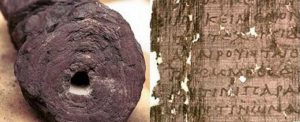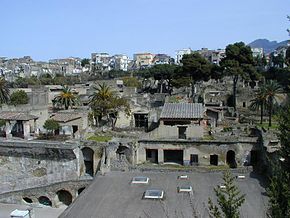Pioneering X-ray imaging has allowed scientists to begin to unravel the mysteries of the Herculaneum “library” – the scrolls that were preserved by the eruption of Mt. Vesuvius in 79 AD. They were discovered among the ruins of a villa in the unfortunate town of Herculaneum. For years, no one has been able to figure out what the scrolls contained because the papyri had been charred into fragile blocks during the eruption.
The X-rays utilized by scientists allow the scrolls to be virtually unrolled, so that scraps of Greek text can be deciphered. This discovery of metal ink reveals the level of sophistication of the technology of ancient Rome and Greece. Prior to this discovery, it was believed that metal ink had not been widely used until about 420 AD.
The scrolls are being examined at the European Synchrotron Radiation Facility (ESRF) by various researchers, one of whom is Dr. Daniel Delattre, a papyrologist affiliated with the Institute for Research and Historic Texts at the French National Centre for Scientific Research.
Commenting on the discovery, Dr. Delattre said: “For nearly 2,000 years, we thought we knew everything, or almost everything, about the composition of antique ink used to write on papyrus.” Delattre and his colleagues examined two fragments of the papyri from Herculaneum, leading them to determine that the ink contained high levels of lead.
This suggested that the metal had been deliberately added to create ink. “The highly specialized studies carried out at the European Synchrotron show us that we must be wary of our ideas and that the ink also contained metal, notably lead in sizeable quantities.” Dr. Delattre added.
Many different scrolls, some intact and others not, have been recovered from Herculaneum, specifically from the Villa of the Papyri, as it is known. One of the most famous writers whose works have been recovered is Philodemus of Gadara. Born around 35 BC, Philodemus was an Epicurean philosopher and poet.
Epicurian philosophy followed the teachings of Epicurus (341 to 270 BC), which claim that the purpose of life was to enjoy a happy, pain-free existence. It encouraged people to surround themselves with friends and to live self-sufficiently. Philodemus himself studied in Athens before moving to Rome and, finally, to Herculaneum. Before the eruption, Herculaneum had been a bustling Roman city. Now, its ruins are a major tourist attraction.
The Herculaneum papyri were originally discovered between the years 1752 and 1754 by workmen who had been hired by the Bourbon royal family. They were digging in the remains of the ancient villa. The excavation of these scrolls continues today.



